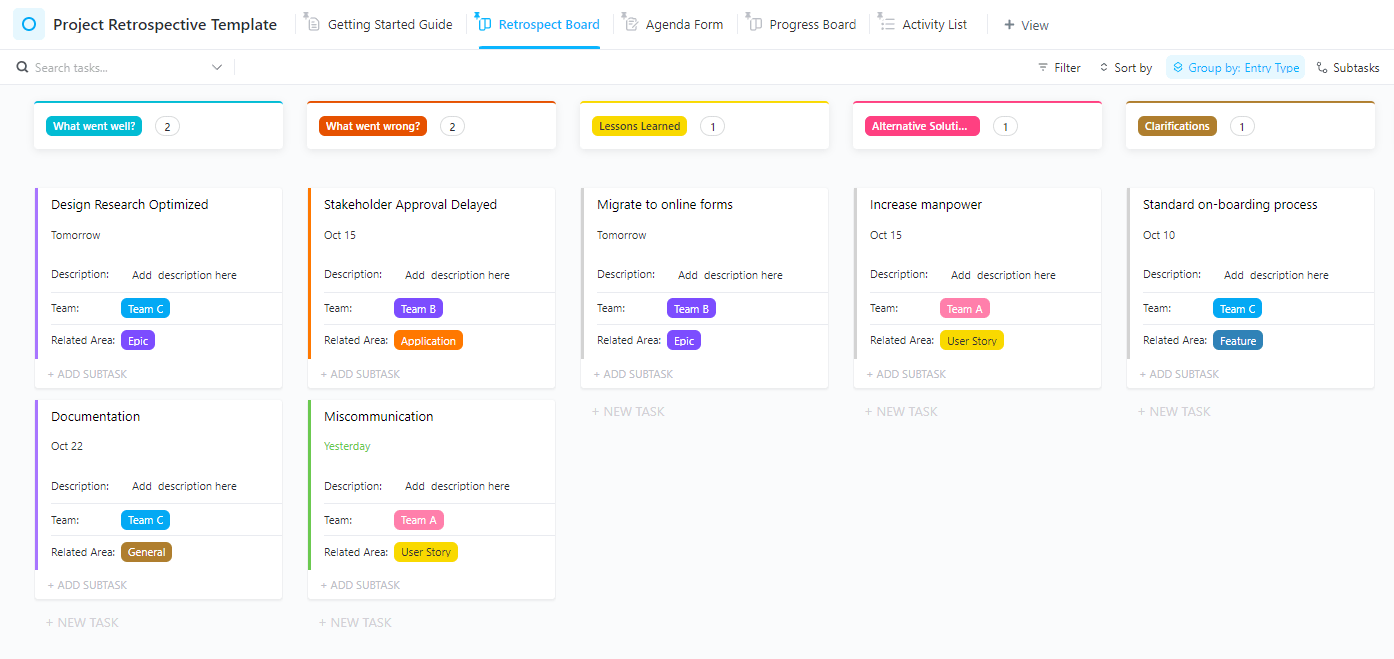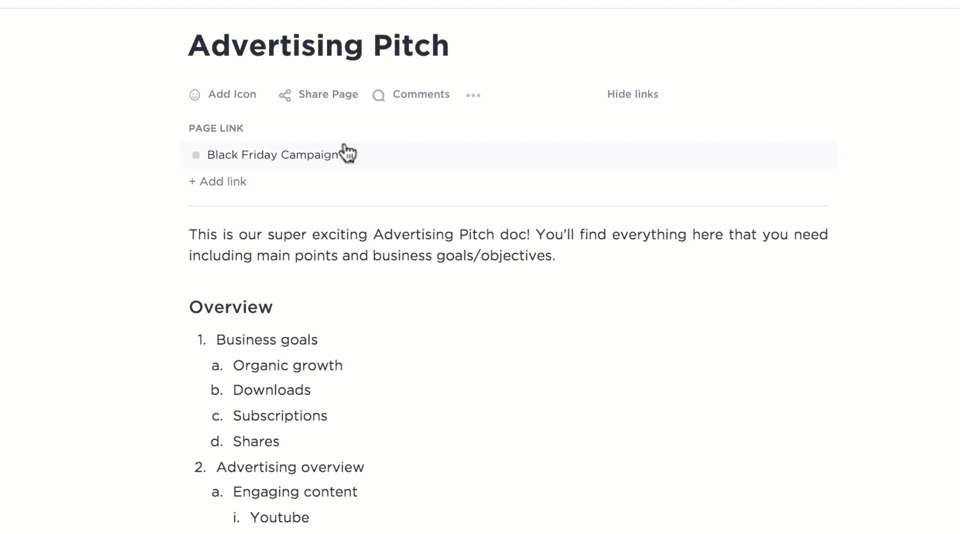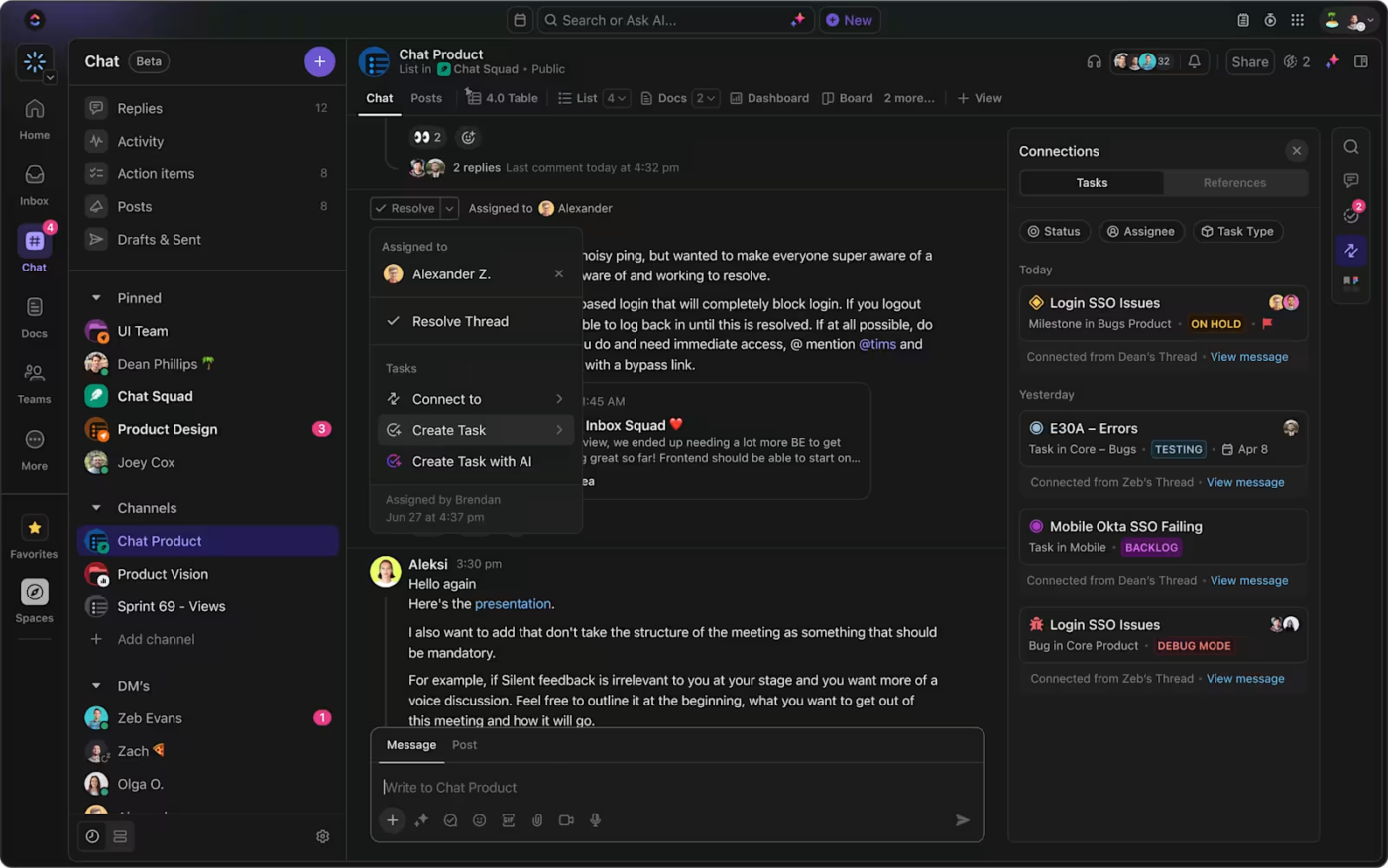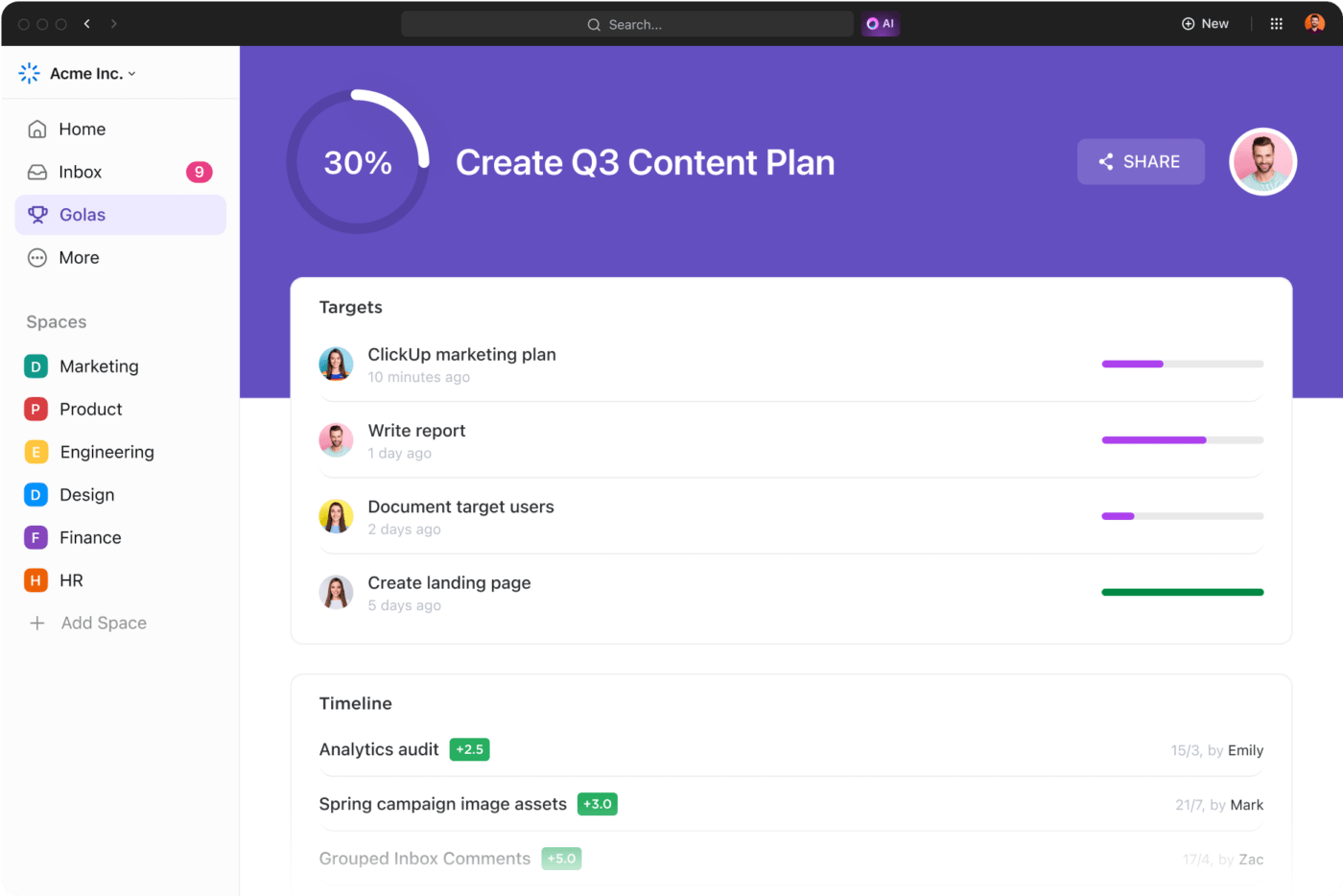How to Implement Rose, Bud, Thorn Method

Sorry, there were no results found for “”
Sorry, there were no results found for “”
Sorry, there were no results found for “”

Ever finished a big project, given a great presentation, or hit a new milestone, and then just moved on without thinking twice? It’s easy to skip the step that actually helps you grow: reflection.
Reflection isn’t overthinking. It’s about taking a moment to look at what went well, what didn’t, and what could happen next.
That’s where the Rose, Bud, and Thorn exercise comes in. It’s a quick and easy way to reflect on your day, a project, or even your personal goals. Whether you’re looking back on a win or a tough moment, this simple tool can help you make sense of it—and move forward with clarity.
Project retrospectives are essential for any successful project, no matter how big or small. That’s why ClickUp’s Project Retrospective Template is here. It helps teams reflect and learn from their experience so that the next time around, the project can be better, faster, and more efficient.
The Rose, Bud, and Thorn is a mindful, reflective activity. It prompts individuals to ponder over the different aspects of a situation or period and come up with three takeaways—Rose, Bud, and Thorns. These metaphors depict:
Think of it as a lessons-learned template that adds structure to reflective activities for personal or professional growth.
⚡Fun Fact: The Rose, Bud, Thorn method was popularized by the Boy Scouts of America as a daily reflection tool. Scouts would identify a positive experience (Rose), a challenge (Thorn), and something to look forward to (Bud) to foster self-awareness and growth.
Here’s a step-by-step guide for implementing the Rose, Bud, and Thorn ideology—at work, schools, or at home:
Start by finding a quiet space where you can focus and brainstorm freely and without any interruptions. Once you’re comfortably settled, decide on the scope of the exercise. For example, if you’re looking to review a project at work, consider whether you wish to reflect on the project idea in its entirety or pinpoint a specific project phase.
Next, collect all the relevant documentation or inputs, such as notes, scope documents, meeting minutes, project assessment templates, etc. Finally, gather all the material you’ll require for the reflection—this could be your journal, a whiteboard, sticky notes, or even a project management tool like ClickUp.
Now’s when you dive into the reflection part of the exercise. Draw a table with three columns—Rose, Bud, and Thorns.
Any positive element of the project or project phase will go into the ‘Roses’ section. This includes:
Then, shift your focus to the future to identify the ‘Buds.’ A bud is a potential rose. To discover these, identify areas where growth and improvement are practically possible. This could involve:
Finally, you fill out the ‘Thorns’—the challenges or obstacles that cropped up during the project or project phase and gave you a hard time. These could be:
Do note that you don’t necessarily have to go in the Rose > Buds > Thorns order. You can simply reflect on the experience and classify incidents across these three parameters.
Performing this exercise would be in vain if it doesn’t translate to actionable planning.
Start by analyzing your Rose, Buds, and Thorns table. Look for patterns or connections between the three elements. Alternatively, you may brainstorm solutions and develop specific action steps for capitalizing on the roses, nurturing the buds, and snipping off the thorns. The objective is to play to your strengths, address any problems, and keep improving!
Since growth and development is an ongoing process, document everything— the Rose, Buds, Thorns table, deliberations, insights, takeaways, project-based learnings, new ideas, and plans. Such documentation can be a valuable tool for future reference and benchmarking progress.
Let’s find out how you can do all of these and more with ClickUp.
💡Pro Tip: Use Rose, Bud, Thorn as a journaling ritual. Set aside five minutes at the end of your day to jot down one rose, one bud, and one thorn. Over time, this helps you spot patterns in your mood, productivity, and focus.
Practicing the Rose, Bud, and Thorn reflection method is a powerful way to gain insights into your projects or daily work. With ClickUp, this process becomes even more effective and actionable. Whether you’re using it for personal or professional use, the following features can facilitate this self-reflective exercise:
ClickUp’s AI-powered features, like ClickUp Brain, can help you quickly identify what’s working well (Roses), spot new opportunities (Buds), and highlight challenges (Thorns) directly from your notes, tasks, or meeting summaries. This not only streamlines your reflection process but also ensures you never miss important details, making continuous improvement a natural part of your workflow.
Check out this video to know more about ClickUp Brain👇
ClickUp Brain is more than an AI assistant. It is a neural network that connects tasks, docs, people, and all of your company’s knowledge base to make it more accessible, navigable, and searchable. Such detailed transparency into the organization’s digital space makes ClickUp Brain highly efficient in conducting in-depth analysis.
Here’s a sample of ClickUp Brain performing the analysis for you 👇


Documentation is a critical step in implementing the Rose, Bud, and Thorn technique. You’ll need a tool to create, edit, and share documents. Enter ClickUp Docs.
ClickUp Docs is a one-stop repository for all your documents. Use it to craft detailed documents that analyze your roses, buds, and thorns. Describe each accomplishment, setback, factors that contributed to it, how it could have been improved, and more. You can unpack insights in granular details—not just on your own but even as a team. Celebrate success, brainstorm solutions, and highlight risks, all on ClickUp Docs.

Use ClickUp’s Kanban View to create a custom board. Divide this Board into three columns— Roses, Buds, and Thorns. Move tasks between these columns to group and categorize outcomes. Roses would be the tasks that were a success, Buds correspond to tasks with room for improvement, and Thorns are the tasks that backfired or failed to take off.
Alternatively, if you’re looking to track progress while also classifying tasks as roses, buds, and thorns, then you can choose ClickUp’s Gantt Chart View. It offers a bird’s eye view of the project. Staying focused on the big picture makes it easier to track dependencies, manage priorities, and collaborate across a visual timeline. As for whether a task is a rose, bud, or thorn, you can use the tagging feature to elaborate on this detail.

ClickUp Chat allows you or your team to quickly share Roses, Buds, and Thorns in real time, making reflection collaborative and immediate. You can gather feedback, discuss observations, and keep all insights organized in one place for easy reference. This streamlines team communication and ensures everyone’s voice is heard during the reflection process.

ClickUp Goals are designed to help you achieve measurable success faster. Setting timelines, defining success metrics, assigning priorities, and tracking progress automatically lays a solid foundation for a goal-focused Rose, Bud, Thorn analysis.
📮ClickUp Insight: Only 12% of people use physical journals to track their goals, and a surprising 38% aren’t tracking at all. But what if you could track goals with more precision and ease?
Enter ClickUp, where the structure of a planner meets the power of automation. From setting tasks and deadlines to tracking progress with visual dashboards, ClickUp helps you stay organized and focused. With AI-powered reminders and automated workflows, you’ll never miss a milestone again.
💫 Real Results: ClickUp users report a 2x boost in productivity

ClickUp Whiteboards are effective tools for collective brainstorming. Think of them as a visual counterpart of ClickUp Docs. Start by using them for team-based reflections and identify the roses, buds, and thorns during a project or its phase. Then work together to identify possible solutions to the problems identified. ClickUp Whiteboards makes it easy to translate your team’s ideas into tasks, workflows, Docs, and more. Having everything in one platform minimizes the possibility of any drop-offs or integration issues.
Let’s talk about the templates available on ClickUp.
ClickUp has a rich library of templates for different use cases, industries, projects, etc. They are 100% customizable and save you time by offering you a prebuilt structure for your reflection exercise.
Some templates that you can use for Rose, Bud, Thorn exercise include:
Also Read: How to Run an Effective Retrospective
Whether you use it for personal reflection or project evaluation, the Rose, Bud, and Thorn exercise offers the following benefits:
👀 Did you know? Exercises like Rose, Bud, Thorn can improve emotional intelligence. By encouraging individuals to label and process emotions, it fosters self-awareness and empathy.
Given the versatile nature of the Rose, Bud, and Thorn technique, virtually anyone can use it as a tool to gain a deep understanding of themselves and their experiences. Such self-reflection catalyzes growth and development.
That said, here’s a breakdown of certain segments who will find it particularly valuable:
At an individual level, you can use the Rose, Bud, Thorn exercise for personal reflection. Here are a few examples of this:
The Rose, Bud, and Thorn exercise is a great tool for team building as it helps with:
Leaders and managers may use the Rose, Bud, and Thorn technique for:
💡Pro Tip: Instead of formal 1:1 check-ins, use Rose, Bud, Thorn to open up a casual conversation about wins, struggles, and growth opportunities. It lowers defenses and encourages honesty—especially with new team members.
Let’s look at some examples of the Rose, Bud, Thorn technique to explain the concept further. We’re covering personal and professional situations to help you visualize the different applications.
Scenario: You’ve committed to a new morning workout. Tomorrow will be 30 days since you’ve been practicing it diligently. You want to celebrate by reflecting on your progress using the Rose, Bud, and Thorn exercise.
Using our step-by-step guide, you get the following table:
| Rose | Bud | Thorn |
| You’ve developed a consistent habit of waking up early in the morning | You could add more structure to your workout routine to target specific muscle groups every day | You sometimes struggle with getting out of bed early for your workout |
| You notice an increase in your energy and stamina levels | You wish to explore cardio and body-weight exercises to add variety | There have been days when you’ve pushed yourself too hard and been tired throughout the day |
| You see an improvement in your strength, flexibility, and mobility | You want to be mindful of your eating habits and adopt a healthy diet to support your fitness goals | You are yet to see the results that you wished to achieve with this workout routine |
Key Takeaways: Staying consistent with your workout routine is a major win. A workout buddy or friends at the gym can help you stay accountable and motivate you to meet your fitness goals. You might also want to reevaluate your fitness goal to see if it is realistically achievable. Discover new exercise techniques and sign up for physical group activities to maximize your results and keep things interesting.
Scenario: Your company recently launched a new product, and you’re the marketing manager who orchestrated the campaign. After the first date of the product’s soft launch, you’re excited to meet your team to review performance and roadmap for the next phase.
In this case, the Rose, Bud, Thorn template would look something like this:
| Rose | Bud | Thorn |
| The website saw a lot of traffic after the campaign launch | There’s room to increase outreach by collaborating with relevant influencers | The unexpected traffic influx caused the website to crash momentarily |
| Social media engagement has been exceptionally high, with above-average impressions, likes, shares, and comments | Analyze metrics and behavior on the product’s landing page to identify areas of improvement | Some customers marked the promotional emails and newsletters as spam, highlighting poor targeting |
| 20% of the target audience has preordered the product and 60% of the remaining display strong signs of intent to purchase | Collect feedback from clients who have placed preorders to gain insights into their purchase experience | A competitor launched a similar product after a few days, causing the interest in your product to fizzle out |
Key Takeaways: You and your team can leave behind the stress and anxiety leading to D-day and celebrate the success of the well-orchestrated campaign. Moving forward, your team can:
We’ve consistently mentioned how the Rose, Bud, Thorn exercise is a versatile tool for various applications—personal and professional. To prove this point, here is a list of some of the common use cases across industries, business value chains, and personal growth where you can apply Rose, Bud, and Thorn’s reflective thinking:
The Rose, Bud, and Thorn technique is a valuable tool during project initiation. By reflecting on past projects and associated experiences, teams can effectively plan project roadmaps, proactively address potential challenges, and deliver successful results.
Here are a few examples of some ways to use the Rose, Bud, and Thorn thinking:

The Rose, Bud, and Thorn assessment caters to the web design and development project’s requirement of continuous improvement and continuous deployment. Here’s how you can use it to refine design thinking while working on web design project management:
Sales and marketing teams leverage the Rose, Bud, and Thorn techniques to refine strategies and optimize campaigns. By reflecting on past successes and challenges, they can craft campaigns that maximize revenue.
Here are some ways to do so:
The Rose, Bud and Thorn technique doubles as a decision-making tool. By reflecting on past experiences, you can weigh out your options and forecast potential outcomes. Such informed decision-making helps make choices that align with your goals and values.
Here’s how you can apply it:

Educators and trainers can use the Rose, Bud, and Thorn strategy to improve their teaching methodologies and learning materials. They can reflect on their classroom sessions to identify areas where students thrived, obstacles students faced, and aspects that can be improved. This improves learning outcomes since you use it for:
Healthcare professionals can utilize the Rose, Bud, and Thorn technique to improve patient care. From identifying treatments that worked to staying wary of the challenges faced during recovery, the Rose, Bud, and Thorns exercise is improving healthcare by:
Committing to acquiring a new skill is daunting. However, with the Rose, Bud, and Thorn technique, you can self-reflect on this ongoing process. Dissecting your experience across strengths, challenges, and growth opportunities allows you to chart your journey and stay motivated.
Here are some ways to apply this:
Whether you’re looking at business or personal relationships, the Rose, Bud, and Thorn technique helps you improve them both. By combining self-reflection and intentional communication, you can cultivate deeper connections that improve social-emotional health. Here are some ways you can use it:
📚 Also Read: If you liked this exercise, you’ll like reading The Six Thinking Hats summary.
The Rose, Bud, and Thorns exercise isn’t just for grand projects or life-altering decisions. It is a powerful tool for cultivating a growth mindset as you reflect on your week or even your day. For instance, a student can use it in school to identify what brought them joy, areas where they can improve their study habits, and revisit challenging concepts. Similarly, professionals may use it to improve their work habits as they identify the roses, buds, and thorns.
Taking the time to write down these moments—big or small—develops mindfulness and gratitude. You appreciate the small wins that made you proud while also recognizing avenues of growth and working toward them. Incorporating this small practice into your routine unlocks a world of personal and professional development.
If you’re looking for a way to make this reflective exercise a habit while organizing your thoughts and reflections, then ClickUp is a great platform. From setting reminders to centralizing data, ClickUp helps you improve: one rose, one bud, and one thorn at a time.
To experience the platform for yourself, sign up for a free ClickUp account today.
© 2025 ClickUp